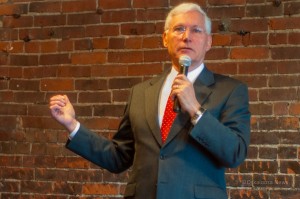Vander Linden Captiol Update 2/12/2015

Rep. Guy Vander Linden (R) addresses those on hand at Eggs & Issues January 24, 2014. (photo by Candace Allsup/Oskaloosa News)
January Figures Bring State Revenue Concerns
State revenues fell in January, raising concerns that the state may not meet last December’s projection for growth during the current fiscal year.
January’s General Fund revenue was $29.5 million (-5.0%) below what the state took in during January 2014. This put revenue growth for the first seven months at a positive $152.4 million, or growth of 4.1 percent. While still positive, state revenue had grown by 5.8 percent through December 2014. Compared to the Revenue Estimating Conference’s FY 2015 projection in December, actual revenue growth is behind the 6.8 percent increase projected. In terms of actual dollars, actual returns are $100.6 million behind the REC projection.
Individual income tax collections were 1.3 percent below those in January 2014. For the fiscal year, individual income tax returns have grown by 4.2 percent. That is below the REC forecast of 5.7 percent growth. As it has been for much of the fiscal year, withholding payments were again higher than last year’s figures. Revenue from estimate payments was down once again. Income tax payments accompanying returns were also down in January (-8.0%) when compared to January 2014.
Sales and Use Tax collections were also below the previous January’s level, with the difference being a negative 6.7 percent this month. For the fiscal year, sales and use collections are running at the 4.4 percent growth level projected by the Revenue Estimating Conference.
Corporate income tax collections for January came in at $32.6 million. This figure is 30.8 percent lower than the January 2014 figure of $47.1 million. For the year, corporate income tax receipts are 5.6 percent below the REC estimate. This figure amounts to a reduction of $17.5 million.
Continuing the month’s trend, tax refunds were also down when compared to what was returned to taxpayers in January 2014. Tax refunds totaled $9.5 million for the month, which was down $3.3 million from last year. For the year, refunds are down 5.1 percent. The Revenue Estimating Conference has projected a 5.4 percent reduction.
While state revenue remains positive for Fiscal Year 2015, the chance that collections could exceed the REC projections is starting to slip away.
Iowa’s Reserve Funds and Ending Balance-An Explanation
As Iowans continue to discuss the proposed state budget for fiscal year 2016 and the level of funding for Iowa schools, some in the education community are urging legislators spend beyond on-going revenue to meet local school needs. This point of view seems to forget the past 30 years of Iowa history and ignore the state’s economic condition.
In the 1980’s, Iowa’s economy was suffering the full effect of the farm crisis. State finances suffered due to the loss of revenue and questionable accounting practices. Schools and local governments were forced to borrow money while they waited for state aid payments, while the Legislature made financial promises it could not keep. The crisis reached a head when the Legislature enacted major budgeting reforms during two special legislative sessions in 1992.
A central tenet of these reforms was the creation of two reserve funds to avoid the mistakes of the 1980’s.
The first of the reserve funds is the Cash Reserve Fund, which allows the state to make on-time payments schools, local governments, health care providers, and others, is required to have an amount deposited in it equal to 7.5 percent of the General Fund budget that year. The Economic Emergency Fund is required to have an amount equal to 2.5 percent of the General Fund budget. It is to be used when the state is experiencing an economic disaster. Each year this amount rises to equal a total of ten percent of the General Fund budget. For Fiscal Year 2015, the amount in the two reserves rose by nearly $50 million to just under $700 million.
When House Republicans took control of the Iowa House in 2011, Iowa’s two reserve funds were not filled to the statutorily-required levels. Governor Culver and Legislative Democrats had spent from the two funds to maintain their spending practices which spent more than the state collected. This fundamentally flawed approach left the two reserve funds $105.8 million short of their statutorily-required levels in fiscal year 2011.
Thanks to fiscal discipline and a strengthening economy, House Republicans were able to restore both the Cash Reserve Fund and the Economic Emergency Fund to their required levels. Maintaining that same fiscal discipline has allowed the state to end the succeeding fiscal years with additional funds in its ending balance. Improving Iowa’s fiscal house has also allowed the state to utilize ending balances in several significant ways.
When states receive federal disaster aid, they are required to pay a matching rate for the funds. This is known as “performance of duty.” These payments are not made when the federal disaster aid is received, but when the funded projects are completed. This makes planning for repayment problematic, as the yearly totals can range from less than $10 million to over $50 million. In 2011, the Legislature decided that it made more sense to have these payments come from the Economic Emergency Fund, since they were addressing disaster aid, which would then be refilled by the General Fund’s ending balance. Also in 2011, the Legislature created a new fund – the Taxpayer Trust Fund. This fund can have up to $60 million a year deposited in it when actual state revenues exceed what the state’s Revenue Estimating Conference has projected for the year. This happened in fiscal years 2012 and 2013, depositing a total of $120 million into the Taxpayer Trust Fund.
Funds deposited in the Taxpayers Trust Fund are then returned to Iowa taxpayers through a tax credit on their income tax returns. It is the only permanent mechanism to return the ending balance to the taxpayers. When Iowans filed their income tax returns in the spring of 2014, they each received a credit of $54. This spring, Iowans will get a credit of $15. The amount is smaller because in Fiscal Year 2014, actual state revenue did not exceed the REC projection and thus no deposit was made in the Taxpayer Trust Fund.
In 2013, the state had a significant ending balance due to a spike in state income tax payments related to the Federal fiscal cliff tax deal and record high farm commodity prices. In response to this, the Legislature passed legislation paying off a series of state bonds. The state paid off over $100 million of bonds for prison construction, Honey Creek State Park, and a part of the Culver I-Jobs program. Paying these debts off early freed up General Fund and Infrastructure funds that had been used to make the annual debt payments.
In the same bill, the state made a series of strategic investments in critical state programs. Leading this was a $20 million investment in the state’s water quality initiative. Addressing the inequity in state university funding was also a priority, as the University of Northern Iowa received $10 million to maintain its programs. And a number of infrastructure projects and equipment investments at the three state universities were made.
With all this activity, the state still ended fiscal year
2014 with an ending balance of $708.6 million. Some have pointed to this one-time funding source as a way to increase on-going funding to schools. But this approach ignores what has happened in fiscal year 2015.
Since the Legislature adjourned in May, state revenue has not met expectations. 2014 ended almost $200 million below the revenue forecast, and the latest projection is that revenue in 2015 will be around $140 million below spending. As of today, the estimate for the fiscal year 2015 ending balance is $451.1 million. If the state had previously spent the entire ending balance, as some in the Democratic minority have suggested, Iowa schools, health care providers, and universities would be facing budget cuts like they experienced during the Culver era.
Also, President Obama signed into law major revisions in the federal tax code. Iowans expect that the state’s tax code will match up with federal tax law. Without the ending balance, that would not have happened with this year’s tax changes. These revisions will provide significant tax relief to farmers and small businesses, the engine of Iowa’s economy.
Iowa’s General Fund ending balance is the backstop for a slowing Iowa economy. Shortsightedly emptying the ending balance for a one-time rise in school funding is exactly the approach taken during the Culver era. It led to across the board budget cuts then and it will lead to long-term problems in the future for all state programs – including the very schools intended to be helped.















